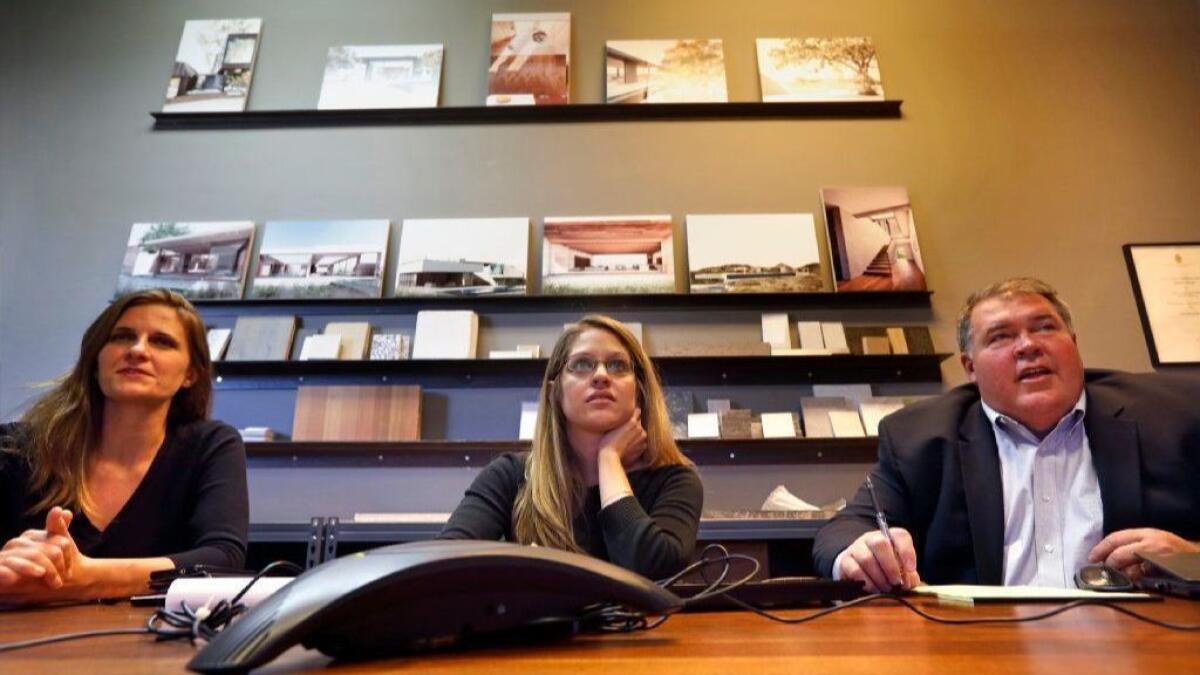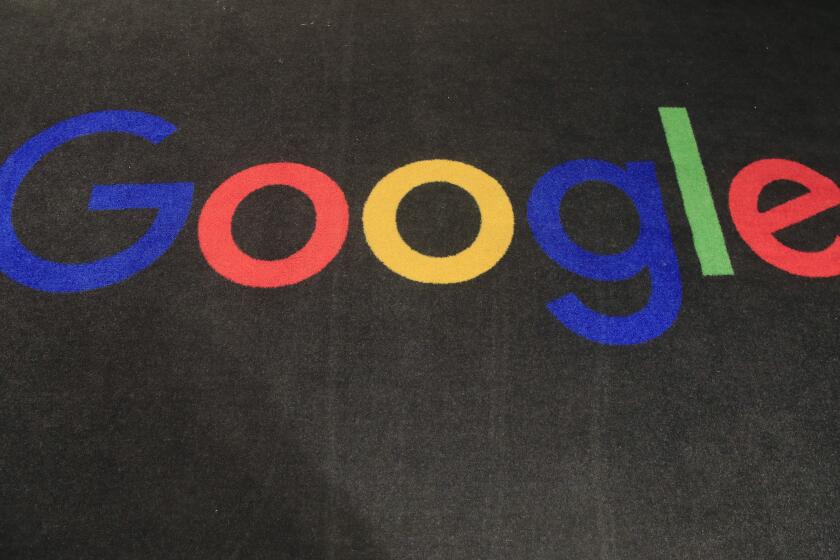Despite court challenge, California pushes forward with retirement program for all workers in state

- Share via
Workers at architecture firm and general contractor Walker Workshop have planned and built high-end homes from Long Island to the Hollywood Hills. But planning for retirement and building savings is another story.
Like many small business, the 16-employee Los Angeles company doesn’t offer a pension or 401(k) plan. Starting in January, though, workers there and at a handful of other companies will be able to start putting money away in state-sponsored retirement accounts.
For the record:
12:05 p.m. Nov. 29, 2018A previous version of this article misquoted state Treasurer John Chiang. He said CalSavers participants receive a form acknowledging the program, not that they must sign a form. The previous version also misstated annual IRA contribution limits as $5,500 for workers under age 50 and $6,500 for those over 50. For 2019, the limits are $6,000 and $7,000, respectively.
They’ll be early participants in CalSavers, a program that — if it overcomes a federal court challenge — could soon offer basic retirement savings accounts to millions of California workers.
Walker Workshop and about 20 other companies are signing up this week to be part of a pilot for the program, which will open to all employers in July. By 2022, state law will require California companies with as few as five employees to either sign up for CalSavers or offer their own retirement savings plans.
DeAnna DeLisle, Walker Workshop’s accounting director and office manager, said the company has looked at retirement plans before, but never pulled the trigger.
“We looked at some retirement options, but they were too expensive or too complicated to administer,” she said. “Some required a company match, but, being a small business, it was hard to lock ourselves into that kind of commitment. Some years are good, some years aren’t.”
CalSavers, though, is free for employers. All they have to do is help workers enroll and deduct money from their paychecks. The program is overseen by a state board and funds are managed by Boston firm State Street Global Advisors.
Workers are enrolled in CalSavers automatically, but can opt out, a system similar to how many companies manage their 401(k) plans. According to research from investment giant Vanguard, workers are more than twice as likely to save for retirement if they are signed up automatically.
But legal questions persist, especially when it comes to automatic enrollment.
The anti-tax group Howard Jarvis Taxpayers Assn. sued California Treasurer John Chiang’s office over CalSavers in May, arguing that the program amounts to an employer-sponsored retirement plan. If that’s the case, CalSavers would be governed by a federal retirement savings law that saddles employers with administrative and compliance costs.
Chiang’s office, backed by California Atty. Gen. Xavier Becerra, argues the program is not subject to — and was designed to avoid — those requirements. That’s because, they say, employees don’t have to sign up and employers are responsible only for helping workers enroll and deducting money from paychecks.
Chiang told the Los Angeles Times earlier this month that he believes the program, including the automatic enrollment feature, complies with federal law, specifically a rule that created a so-called safe harbor for certain retirement plans as long as employers themselves have little involvement and plans are “completely voluntary” for workers.
“Participants get the form; they acknowledge this program,” he said. “We think this fits within the safe harbor.”
But on that point, federal District Judge Morrison England has questions. Last month, England asked Chiang’s office and the Howard Jarvis Taxpayers Assn. to weigh in on a few issues, including whether the program can rightly be called “completely voluntary.”
If the program meets that definition, it may be clear of the additional federal scrutiny and tilt the case in the state’s favor. If not, it could strengthen the taxpayer group’s case.
Chiang and Becerra filed a motion to dismiss the case in July. England has yet to rule on that motion.
Jon Coupal, president of the Howard Jarvis Taxpayers Assn., said he believes the judge’s questions about the “completely voluntary” language suggest that he is not likely to dismiss the case. And given that the case may proceed, Coupal said it seems irresponsible for the state to press ahead with even a CalSavers pilot.
“The state has been extraordinarily irresponsible by continuing to implement this program while there’s a significant legal cloud hanging over it,” Coupal said.
Katie Selenski, executive director of the CalSavers program, said Monday that she is not concerned about the lawsuit or about proceeding before there’s a legal resolution.
“We’re very confident we’re on solid legal ground and we’re proceeding as planned,” she said.
California lawmakers, led by state Sen. Kevin de León (D-Los Angeles), passed legislation to create CalSavers — initially called California Secure Choice — in 2016. Chiang’s office has been working since then to sort out program details and bring it to fruition.
The program was designed to offer an easy path to retirement savings for the estimated 7.5 million California workers who don’t have a retirement plan through work. Workers who don’t have access to employer-sponsored plans can start retirement savings accounts on their own, though few actually do so.
CalSavers is not a pension program. Rather, it’s a state program that offers individual retirement accounts to workers. The accounts are not guaranteed by the state and investors may lose money.
CalSavers account holders will have to pay management and record-keeping fees of between 0.85% and 0.92% of their account balances annually — that’s between 85 cents and 92 cents for every $100 — though those fees will drop to as low as 0.23% as more workers enroll and more assets are invested through the program.
For now, CalSavers offers only Roth IRAs, but starting in July will offer traditional IRAs as well. A traditional IRA invests pre-tax earnings, but withdrawals are taxed as income. A Roth IRA invests already taxed earnings, but withdrawals are not taxed.
Workers can choose to invest as little as 1% of their earnings and as much as the federal IRA investment limit of $6,000 annually. Workers over age 50 can invest up to $7,000. Unlike with a 401(k), employers cannot match employees’ CalSavers contributions.
By default, when workers enroll, they’ll contribute 5% of their earnings to their CalSavers accounts. A worker’s first $1,000 in contributions will be invested in a money-market fund with the rest invested in a target-date fund, which holds different mixes of stocks, bonds and other investments that vary based on the expected retirement date.
CalSavers account holders can choose from a menu of investment options, including a money-market fund, a bond fund, two stock funds and several target-date funds.
The legality of the program at first seemed secure. In 2016, the federal Department of Labor, which oversees employee retirement plans, issued a new rule saying that state-sponsored retirement savings programs would be exempt from federal retirement savings laws.
That was in response to requests from California and other states — including Oregon and Illinois — looking to create such programs.
But last year, Republicans in Congress voted to scrap the new rule. Coupal and other critics say that should have put a stop to CalSavers.
Chiang and Selenski, though, have said the Labor Department rule was never strictly necessary and that state leaders only asked for it to make business groups feel more comfortable with the program.
“That was for the chambers of commerce to help them feel more confident that employers would not be subject to those rules,” Selenski told The Times last year.
Twitter: @jrkoren
More to Read
Inside the business of entertainment
The Wide Shot brings you news, analysis and insights on everything from streaming wars to production — and what it all means for the future.
You may occasionally receive promotional content from the Los Angeles Times.











